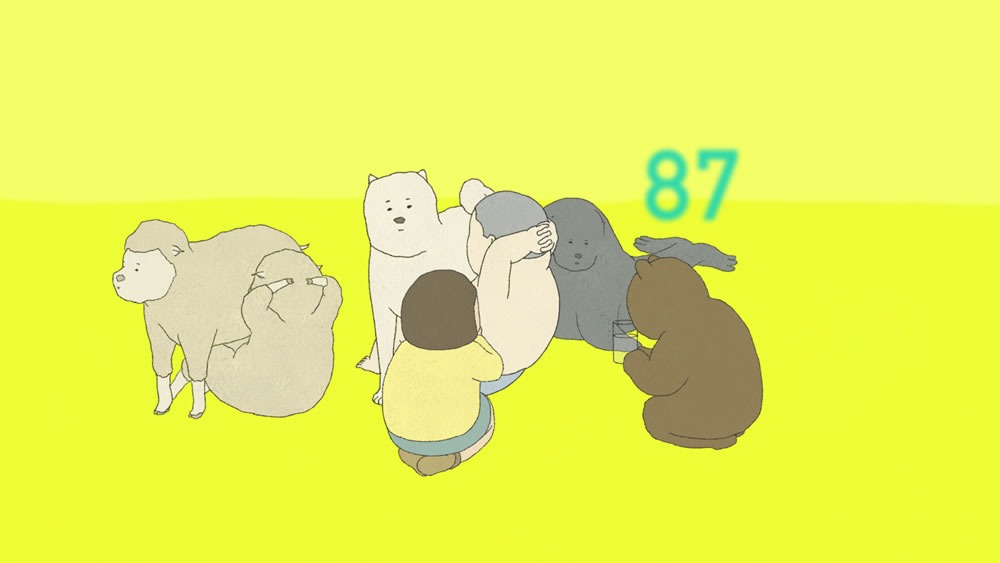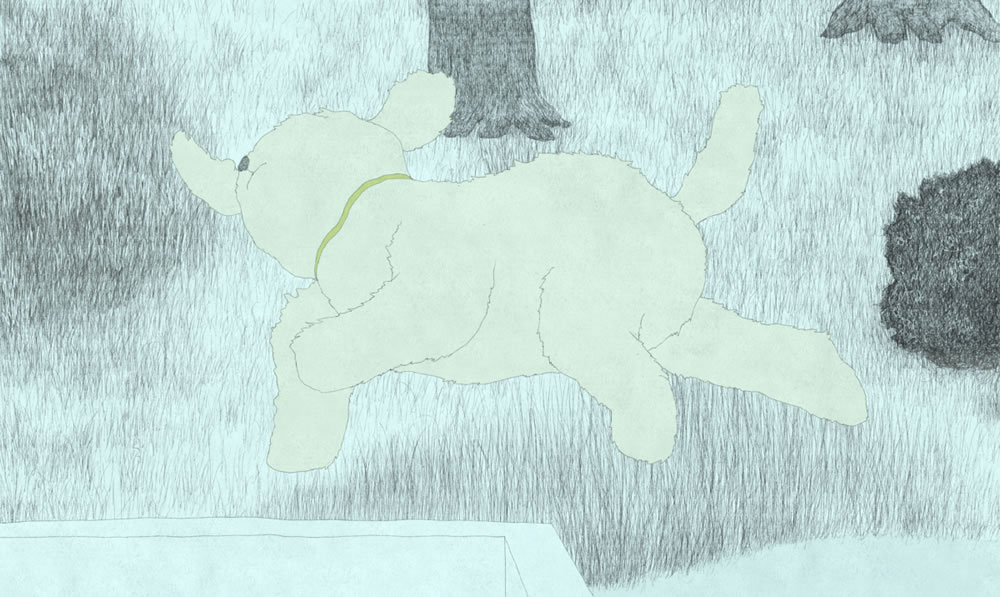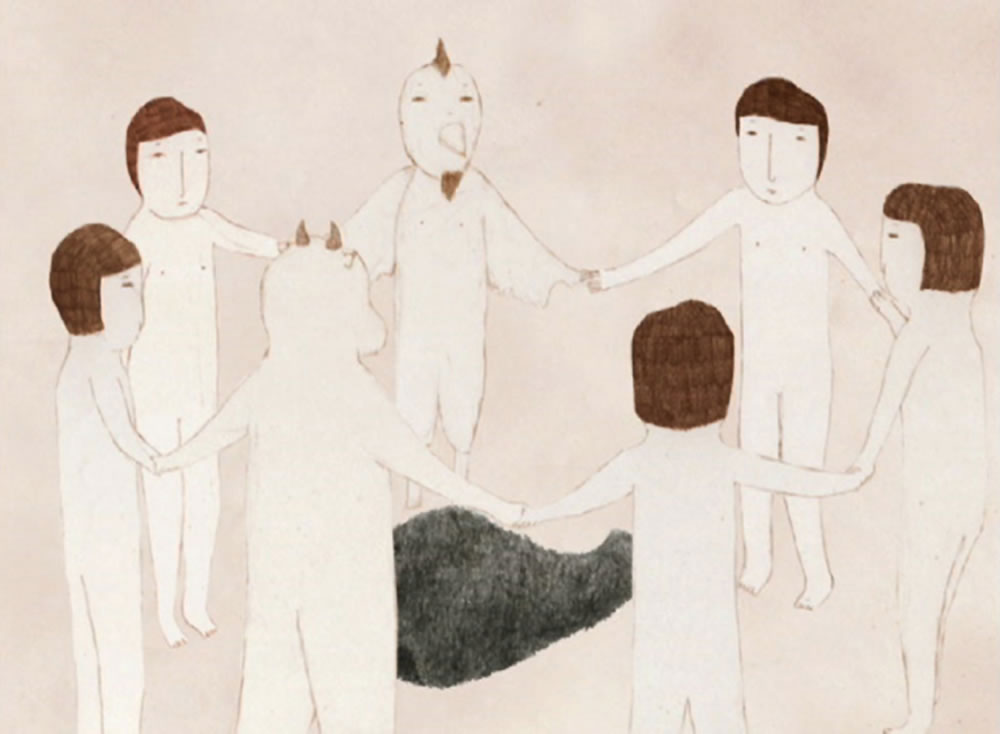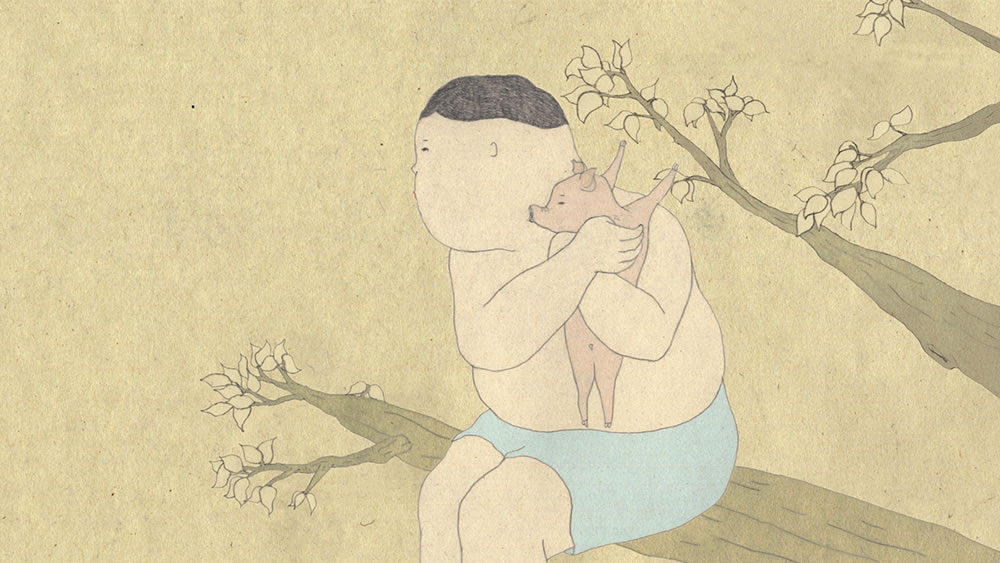WADA Atsushi is an award-winning animation artist whose works having intriguing and mysterious atmosphere with memorable characters have been highly acclaimed at film festivals around the world. He released his first video game, My Exercise (available on Steam/iOS/itch.io), in August 2020. We recently interviewed with WADA to hear about this work and its production and also his past and upcoming works.
 From My Exercise
From My Exercise
Story unfolds with a boy’s abdominal muscles
WADA Atsushi is a self-taught animation artist who began being active around 2002. He has continued to create animations themed on the Japanese concept of “ma,” the tension produced between movements and “comfortable movements.” His In a Pig’s Eye (2010) and The Great Rabbit (2012) respectively won an excellence award in the anime category at the 14th and 16th Japan Media Arts Festival of Cultural Affairs Agency. The Great Rabbit also won the Silver Bear at the short film division of the Berlin International Film Festival. WADA held a solo exhibition, titled, My Marsh, at the Yokohama Museum of Art in 2017 and at the Hyogo Prefectural Museum of Art in 2018.
 From My Marsh, which was commissioned by the Yokohama Museum of Art
From My Marsh, which was commissioned by the Yokohama Museum of Art
My Exercise is WADA’s first video game released in August 2020 as a mobile game. Its producer was DOI Nobuaki, an animation researcher and representative of New Deer, Inc. In this game, each time you touch the display, the chubby boy does one sit-up. As this process continues, animation changes. In this interview, we asked WADA about My Exercise, especially why he started producing a video game, as well as about his past and upcoming works.
First of all, we’d like to hear about your game My Exercise. Although it was made with animation techniques, you probably felt making this work was very different from making animation, which you’ve been dedicated to so far.
WADA: I made animation images as I usually do, but when it comes to finishing it as a game, I was a total newcomer to the field. I went through a lot of trial and error by working with the producer DOI Nobuaki, who is also an expert on video games, and USUHA Ryoya, an animator who has experience in game production. As I usually work by myself, working as a team like this was new and different from my style. It was rather a fresh experience for me. This video game was released as my work, but I never feel I made it alone. For me, it was a project by the three of us as a core team and also involving specialists in various fields. I greatly enjoyed this process as being different from my usual style.
Around 2010, when iPhone began to spread widely, there was an increase in app games using animation. How did you feel about that trend as an animator?
WADA: To begin with, I usually don’t play games very much and I don’t have much knowledge about games. I’ve never been deeply immersed in playing games. In fact, I hadn’t been much interested in games until I worked on My Exercise.
You are that type of person, so you were probably able to think about the nature of the game as a medium from the very basic and design the animation for it without bias.
WADA: After all, video games are an interactive media. Games and video works are naturally different regarding their directions of communication. Video works are provided unilaterally, so video artists can control the timing of movements, etc. But games involve players. I was concerned whether I would be able to effectively express “ma,” which is very important for me when making animations, also in a video game that involves the players. I was worried that the “ma” that I want to express may be changed by the pace of the player as we have no choice but to leave various matters to each player and their involvement.
Through discussions, the producer DOI and I decided that our first priority would be to express “movements that make people feel good” when seeing this work. We thought of presenting to the players certain movements that the players can experience and be involved in and “feel good” as a result. Through trial and error, we were gradually settling down on the basic idea of letting people “feel good” from the movements of repeatedly making situps while various people and animals are gathering around more and more at the place.
It is innovative that the fundamental of this game is the act of watching the same animation over and over again. By watching it over and over again, the players can better appreciate the characteristic of your animation. They are also able to have the experience of “feeling good,” which was achieved by repeating a movement, not doing it only once.
WADA: I’m very happy to hear that. My Exercise has a short film version (*1), too, which features push-ups and squats, in addition to sit-ups. I, at first thought about including pushups and squats in the game version, just like in this short film. But in the end, I decided to focus only on one action of doing sit-ups and their movements, and explore what I could do with them. This is how we finished a game that is really about doing sit-ups alone (laughs). Considering its uniqueness, we knew we should think hard about whether this game would be accepted by the public. We paid much attention to how we could develop the basic idea in order to maintain the player’s interest until the end.
 A flyer for an event, titled, My Discreet and Private Charm that Moves, marking the release of the game My Exercise by screening works by WADA Atsushi
A flyer for an event, titled, My Discreet and Private Charm that Moves, marking the release of the game My Exercise by screening works by WADA Atsushi
Before his unique style was established
I’d like to ask you a bit more about “comfortable movements” and “ma.” How many animated frames do you make per second in terms of komauchi, fundamental technique (*2) in your work?
WADA: In early years of my career, I didn’t have awareness or knowledge of komauchi. I made animations just by feel. I remember I started out with a three-komauchi (three-frame animation, or drawing different pictures on eight of the 24 frames per second). Around the time when I made Day of Nose (2005), I put the focus of my work on depicting movements by animation, and I started to pursue “comfortable movements” for me. I started to make two-komauchi (twoframe animation, or drawing different pictures on 12 of the 24 frames). For some scenes, I used full animation (animated at all the 24 frames per second) for some scenes.
 From Day of Nose
From Day of Nose
In your animations, there are often sudden scene changes. In My Exercise, when a sea lion is about to appear, the screen image changes abruptly to a close-up of its lower body. Is this kind of close-up technique also important for creating “ma,” which you think is important?
WADA: I have two reasons for making sudden close-ups. The first reason is that I place emphasis on something by presenting its close-up and create a sense of tension on the screen. It makes an impact on the audience or players, attracts their attention to the image, and maintains their concentration on watching what happens next. The other reason is that I want the audience to guess how the subject of the close-up is feeling. Many characters in my work are expressionless. By drawing their close-ups, I hope I can evoke the audience’s perception of what the character is thinking and how they should understand it.
You just referred to expressionless characters. Your characters remind me of symbolic figures in Chinese or Japanese artworks.
WADA: Originally, I got into animation because I wanted to move things I doodled in class at school. At the time, they were like Modigliani. An office worker having a narrow face and thin body appears in many of my early works. But actually, I think I was most influenced by Buddhist paintings. I was attracted to thin, even lines and expressionless faces in Buddhist paintings. These paintings don’t convey the emotions of persons, but rather let the individual viewer think about their emotions and perceive differently. I also liked the faded, changed texture of old Buddhist paintings. This way, the visual aspect of my work is greatly influenced by Buddhist paintings.
I feel your coloring is also influenced by Buddhist paintings.
WADA: I’ve never been good at coloring. From the beginning, I didn’t use many colors in my works intentionally. In place of using many colors, I wanted to create a characteristic texture. I thought hard how I could bring the old and blurry texture of Buddhist paintings into my animations. For example, I was particularly conscious of this texture when making In a Pig’s Eye. I drew a picture on straw paper with a mechanical pencil, scanned it, and then increased its contrast to create a unique texture.
 From In a Pig’s Eye
From In a Pig’s Eye
Your work frequently features animals. There must be some reasons, too.
WADA: I love animals, so they almost always appear in my works. When I select an animal for a work, it is a particular animal that I like at the time, or “the boom animal in me.” Otters are the boom these days, so they often appear in my recent works (laughs). But I haven’t made works only about animals. I always include humans, partly because I want to depict the relationship between animals and humans. I treat humans and animals flatly in animation and depict the gap between their relations, while I want the viewer to think about their respective situations.
You deform the shapes of animals to a diverse of degrees. The pig in In a Pig’s Eye is depicted like a real pig. In contrast, the bear in the game version of My Exercise sits on its heels and pours water out of a glass.
WADA: I basically want to draw animals realistically. If they look deformed, it’s because I can only draw them that way, which is a technical problem. About the bear in the game version of My Exercise, I tried hard to draw a bear that looks real, but it turned out to sit on its heels. In a sense, I’m relatively lax in defining realism.
Your works are unique not only about drawings but also about sound effects.
WADA: Usually, I almost determine the image of the sounds I’ll use before the storyboarding stage of each work. When depicting “comfortable movement,” I think “comfortable sounds” are as important as “comfortable movements.”
I created all the sounds by myself up until In a Pig’s Eye. I took my time at home looking for the right sounds, having an IC recorder in hand. Currently, I work with the sound designer TAKINO Masumi to create sound effects. In the past, I asked sound designers to process my own recordings. I’ve been working with TAKINO for seven or eight years, so these days, she can exactly sense what I want these days. We now have a very comfortable work relationship with each other.
When you make storyboards, how much detailed are they?
WADA: Storyboards are necessary for a film that involves a producer. In my case, I make them like giving shape to what I have in my head. I draw animation while thinking and making changes. I think about how to develop a work while drawing with my hands while using my senses.
After the release of My Exercise
The game version of My Exercise seems to have been recognized by people who don’t usually see your animations. For example, a YouTuber plays it in a video. Do you feel you were able to attract new people?
WADA: I wouldn’t have made a game without DOI’s suggestion as it’s an unknown field for me. Even if I had made, I wouldn’t have been able to deploy it by myself as I had no know-how. Once I made it, a lot of things happened here and there, which I had never imagined.
When I was offered to create a video game, I was aware I couldn’t do it alone and rather thought it would be challenging and interesting as there would be many new things for me. I wanted people to play My Exercise as they like, so I’m glad that this game is attracting people whom I wouldn’t have been able to attract, if making only video works.
What does animation mean to you as a video genre?
WADA: I don’t have a clear idea of how animation should be like. I’m not deeply interested in animation itself very much or think about it. Rather, whenever I had something interesting for me or what I want to do, I found animation is the best method to embody it. I think this method or genre are best suited to my personality and nature.
How will be your next work Bird in the Peninsula like, which is scheduled for release in 2021?
WADA: Let me talk about a documentary I watched some time ago. It was very impressive. I’m now making a work using it as a motif. In the documentary, children were practicing a traditional village festival dance. They didn’t look enjoying at all (laughs). Their complex emotions I experienced at that time were difficult to explain and have been lingering on in my mind.
I’ve often used rituals involving several people dancing in a circle as a motif in my works. This time, I want to ask a basic question on “what a ritual is.” In the past, I’ve only been motivated by my “love of movements in animation.” In my new work, I want to make the contents more elaborate. I’m thinking about rituals and what they are, while making this work.
Before finishing this interview, please tell us what you want to do in the video game genre in the future.
WADA: I’d had the idea of repeatedly doing sit-ups before the game project was proposed. My Exercise was produced as this favorite idea of mine happened to match the game plan. Now that I know how to make a game to some extent, I think it interesting to do something that can be done only in the genre or to pursue areas that enhance the interactive relationship with players.
WADA has been pursuing “comfortable movements” throughout his career. This interview has found out how he designs and incorporates such movements into animations in terms of his drawing, colors and sounds. In taking on the challenge of making a video game, which is a new field for him, he made the most use of his expertise in making animation films and succeeded in conveying “comfortable movements” to an audience who had never watched his works. WADA also talked about the concept of his next work, Bird in the Peninsula, and hinted at the possibility of working on a new video game as well. I felt his unique style will further expand and develop in the future.
(notes)
*1
A video work giving an overview of WADA’s career, My Discreet and Private Charm that Moves was screened at Eurospace in Shibuya, Tokyo, from September 19 to October 2, 2020, marking the release of the game My Exercise. This video includes a two-minute, edited version of My Exercise (a short film version), The Great Rabbit, and TV commercials, enabling viewers to experience the charm of WADA’s works comprehensively.
*2
Komauchi is a fundamental technique of making animation films regarding the number of different pictures drawn on 24 frames per second. In full animation, or one-komauchi, a different picture is drawn on each of the 24 frames per second, producing a smooth motion. In three-komauchi, a picture is on every three consecutive frames, producing a little rough, stylized motion.
(information)
My Exercise
Concept and Animation: WADA Atsushi
Code: USUHA Ryoya
Advisor and Publisher: Playables
Producer: DOI Nobuaki (New Deer, Inc.)
Produced by: New Deer, Inc.
Release: August 2020, available on Steam, iOS and itch.io
Play time: 20 minutes + ∞
https://myex.jp/en/landing
*URL links were confirmed on November 11, 2020.











